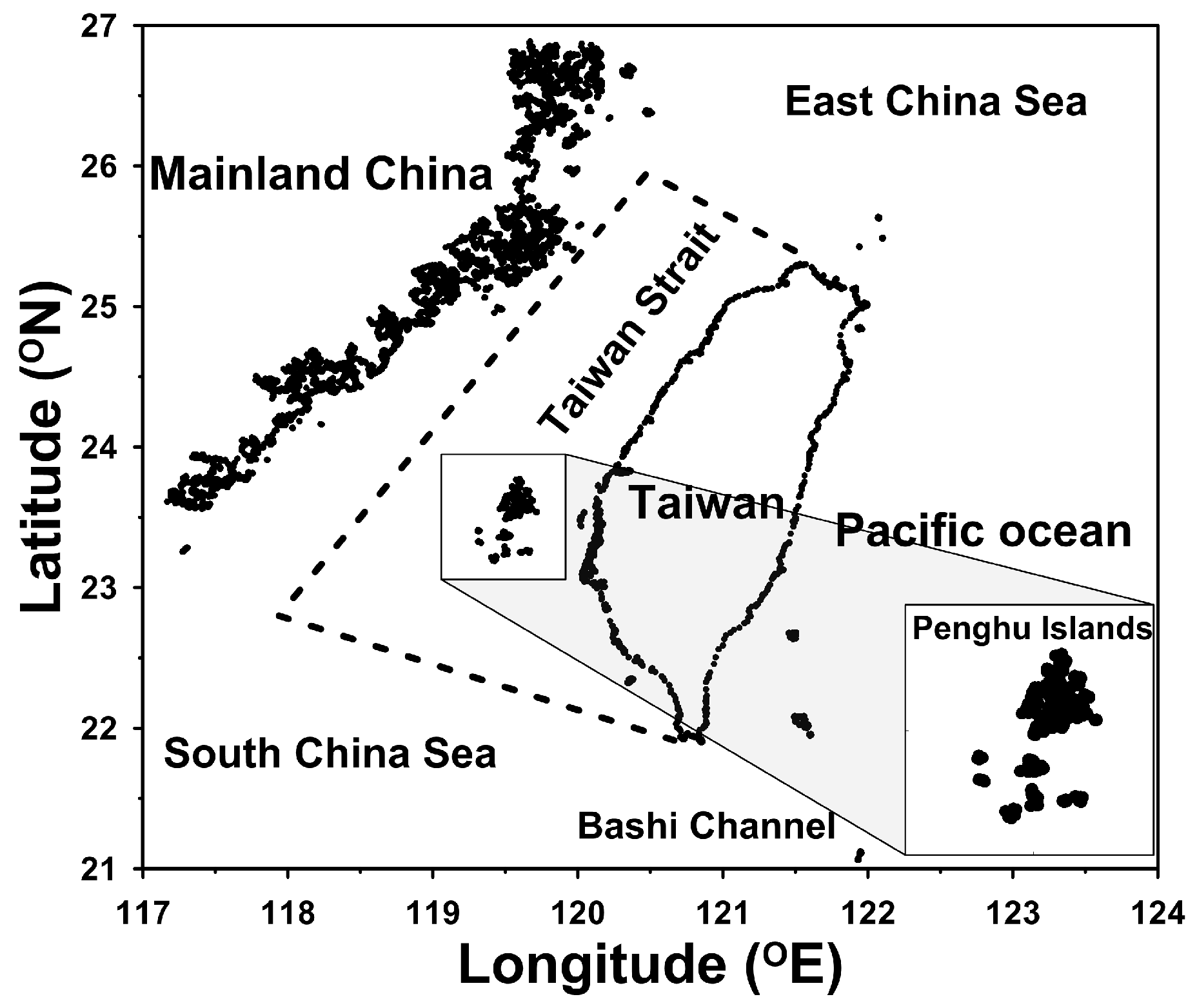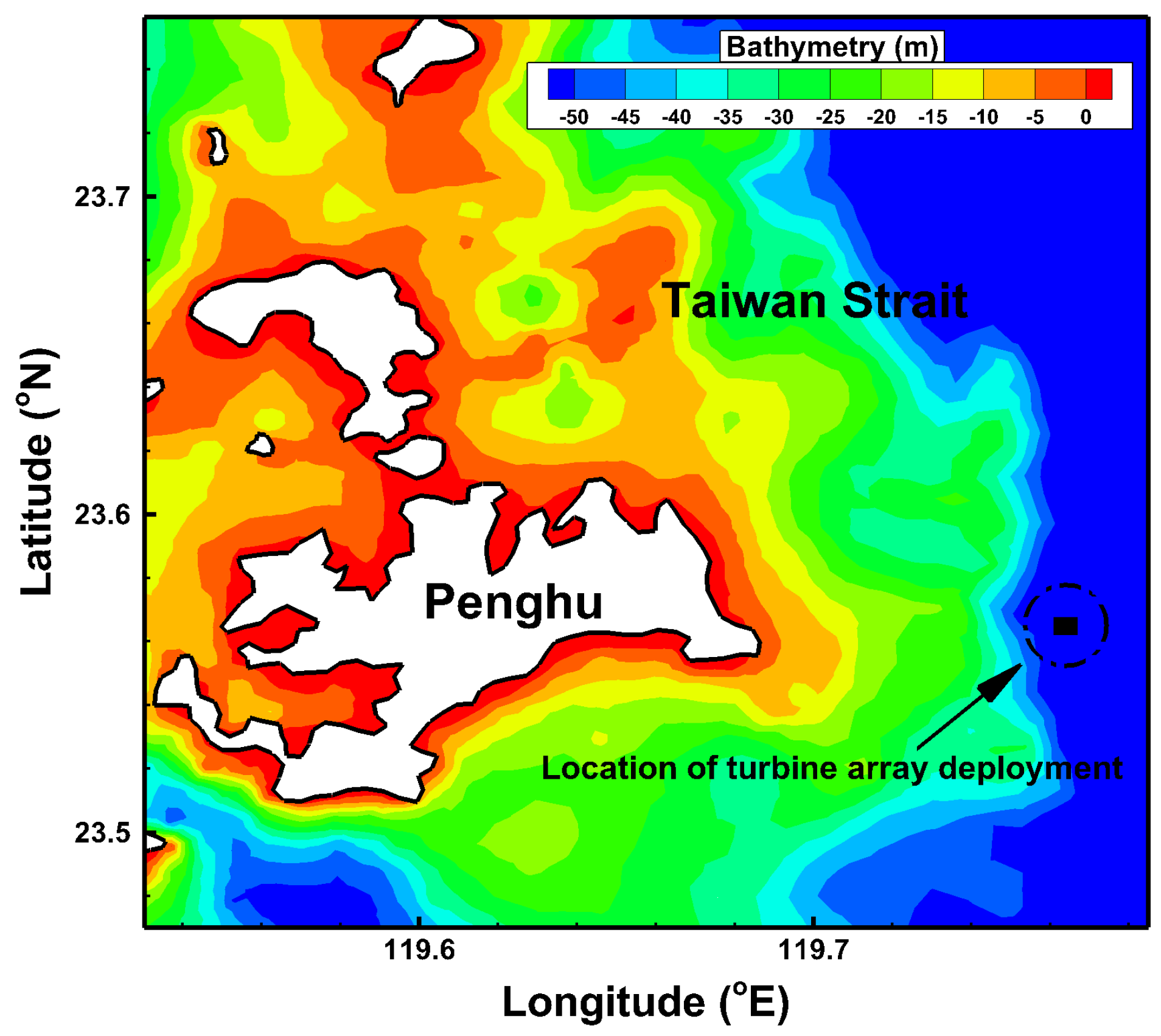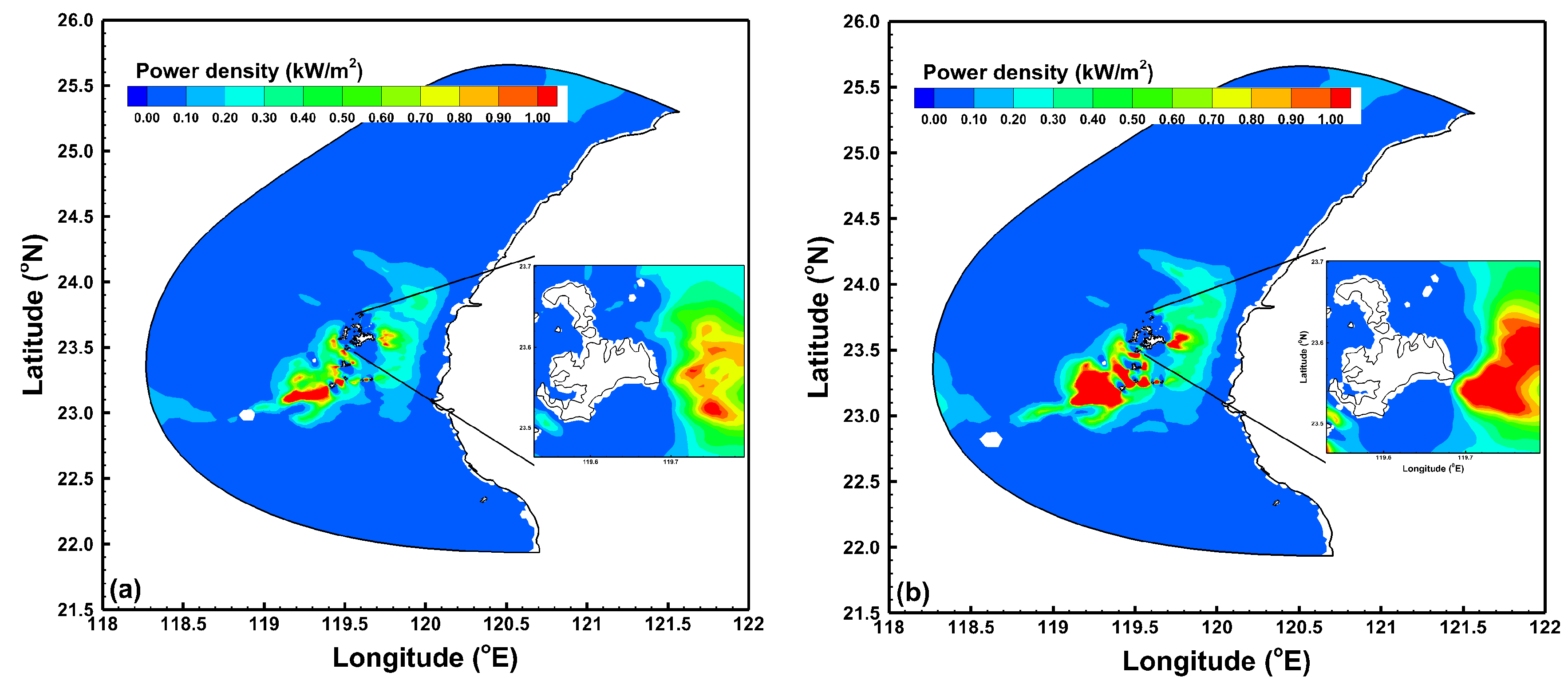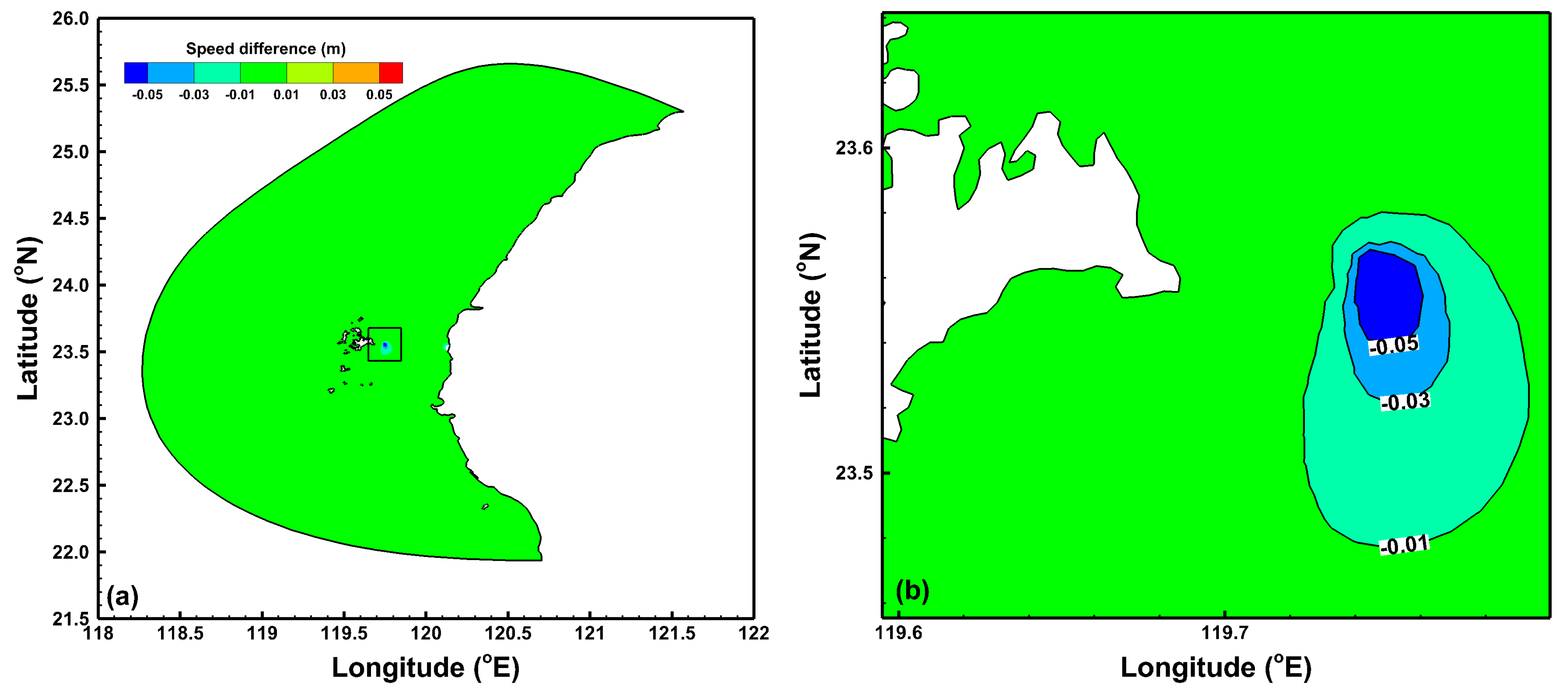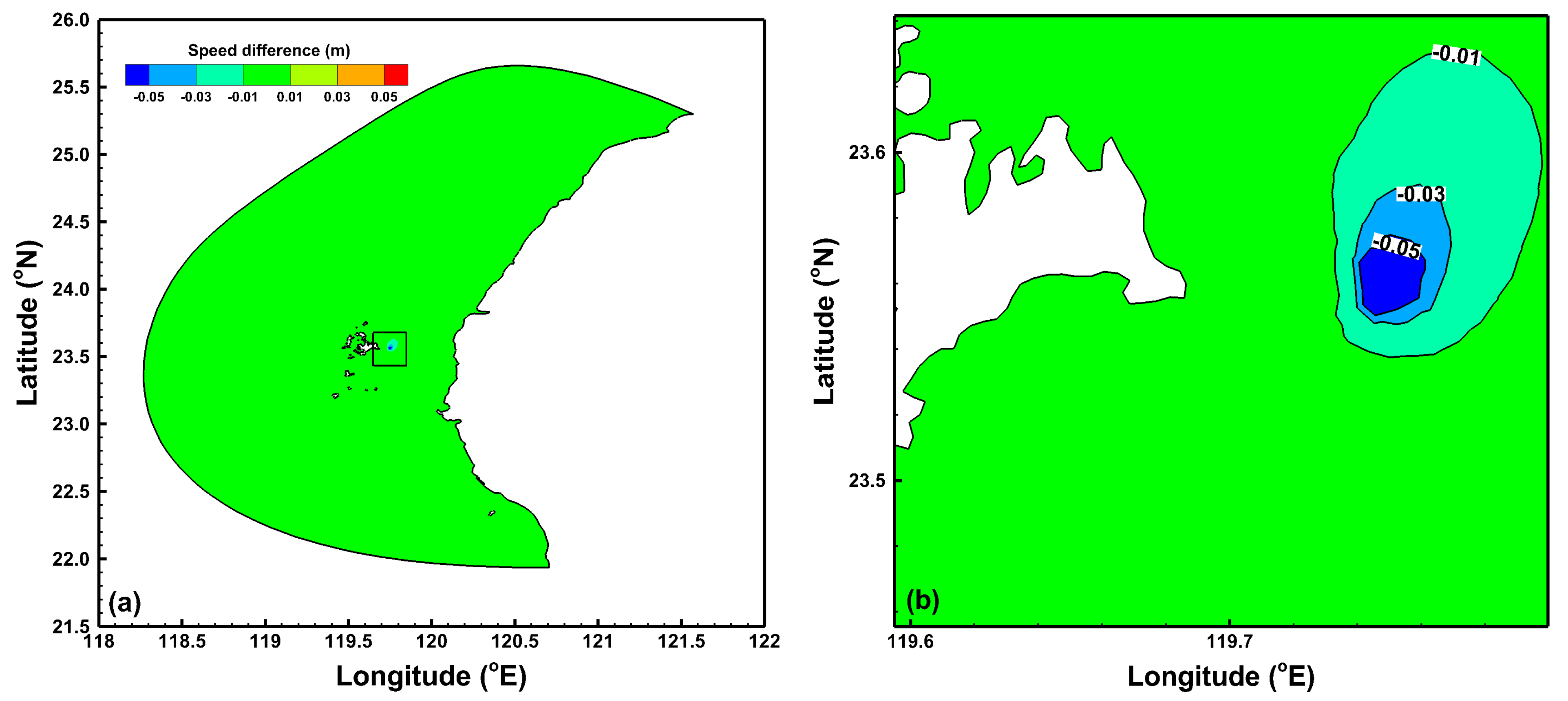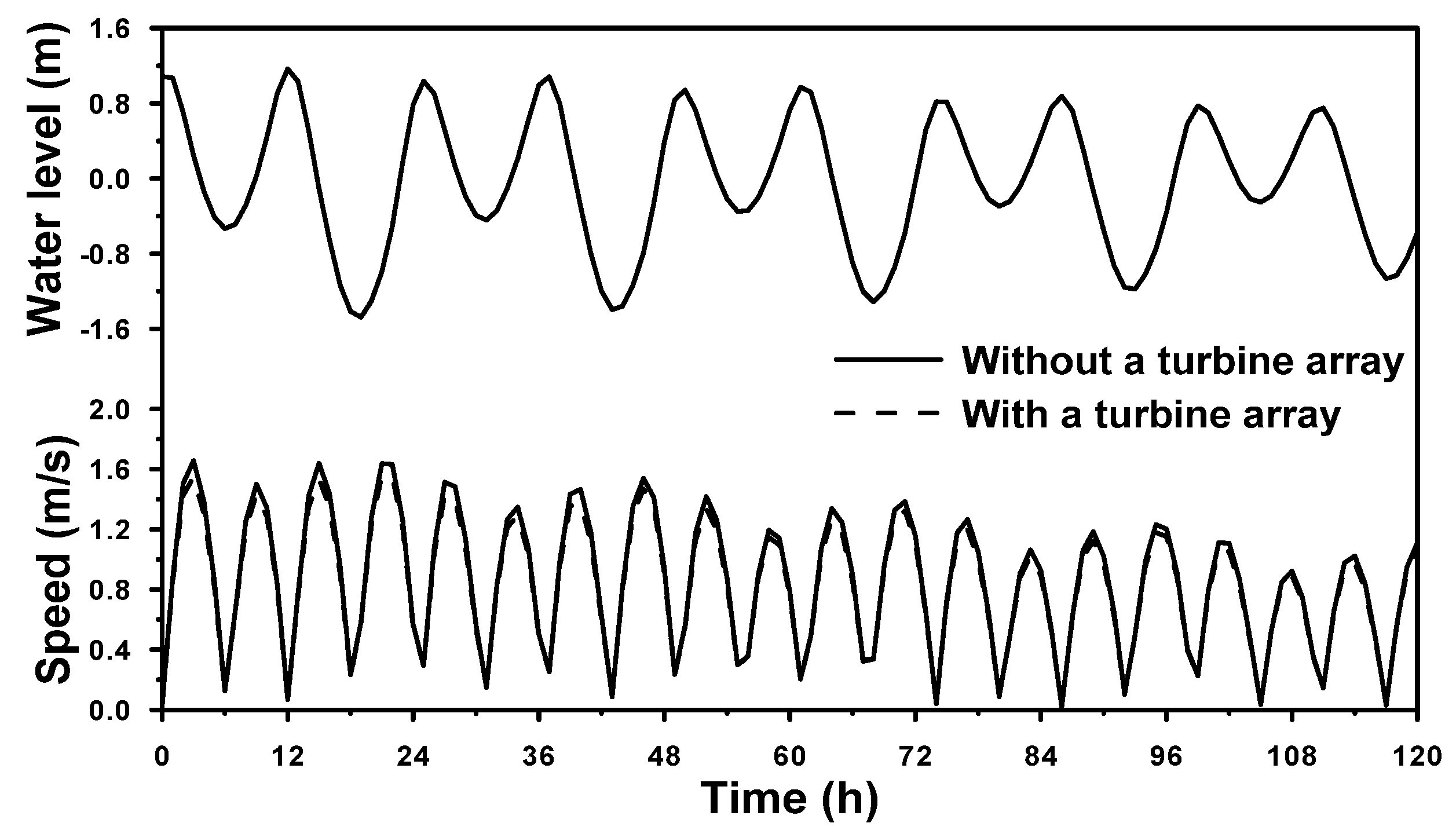1. Introduction
Traditional fossil fuel energy sources, such as oil, natural gas, and coal, have been explored and used in great amounts since the Industrial Revolution and are therefore gradually depleting. Additionally, traditional energy sources can cause environmental impacts, such as the greenhouse effect and environmental pollution, making reduced dependence on these sources a widespread goal. Renewable energies are sustainable and clean energy sources that offer the potential to mitigate the depletion of traditional fossil fuels and their associated environmental impacts, while also resolving the issues of economic development and environmental protection. During the last decade, the development and application of renewable energies have accelerated [
1,
2].
The development of renewable energy may be necessary to solve these energy issues. The renewable energy reserves of Taiwan are actually rich. The potential renewable energies include solar, wind, biomass, ocean, geothermal, and hydropower [
2]. Taiwan is surrounded by sea and has a coastline of over 1500 km. An abundance of wave and tidal stream energy may be available. In this paper, we limit our discussion to tidal stream energy.
Tidal energy has two components. The first is the potential energy due to sea level variations, and the second is the kinetic energy of tidal streams. Tidal barrages have been successfully employed for some time. There are several commercially operational tidal power plants: La Rance, France (240 MW capacity, built in 1966); Kislata Guba Bay, Russia (1.7 MW, 1968); Jiangxia, China (3.2 MV, 1980); Annapolis, Canada (20 MW, 1985); Stranglord Lough, Northern Ireland (1.2 MV, 2008); Uldolmok, South Korea (1.0 MV, 2009), and South Korea (254 MV, 2011). Tidal current energy technologies, however, is only now reaching a stage where commercial viability might be achieved and so far no arrays of tidal turbines have been deployed anywhere. For tidal turbines there have been a number of deployments at the European Marine Energy Centre, where electricity was generated and fed into the grid. Strangford Lough device, which uses twin 16 m diameter rotors [
3], and the Uldolmok device [
4] are therefore not the only operational large-scale tidal stream turbines. None of these tidal stream devices are commercially viable yet. Projects using tidal barrages to produce energy result in extensive environmental impacts, including potential effects on coastal ecosystems and fisheries, disruption of navigation, and high capital costs.
This situation has changed with recent developments in turbine technology, which allow the production of electricity using tidal streams. The kinetic energy of the flow is used, whereas tidal barrages use potential energy. Tidal current energy has several advantages, including the high predictability of tides, the high power density of water flow, the development of turbine technology, the lower investment relative to barrage structures, and the lower ecological impact compared with large hydraulic structures [
5].
Several researchers have used numerical modeling to assess tidal stream energy resources. Blunden and Bahaj [
6] applied a two-dimensional tidally driven hydrodynamic numerical model (TELEMAC-2D) to estimate the available tidal stream energy resources at Portland Bill, UK. Sutherland
et al. [
7] adopted a two-dimensional finite element model (TIDE2D) to evaluate the maximum tidal power potential of the Johnstone Strait, BC, Canada. Carballo
et al. [
5] applied a two-dimensional horizontal finite element model to evaluate the tidal stream energy resources in the Ria de Muros, which is in the northwestern coast of Spain. Xia
et al. [
8] used a refined depth-integrated two-dimensional hydrodynamic model to assess the potential tidal stream energy resources with and without the Severn Barrage in the Severn Estuary, UK. Chen
et al. [
9] refined a three-dimensional hydrodynamic model to evaluate the tidal stream energy at Kinmen Island in Taiwan. Yang
et al. [
10] presented a three-dimensional model to study in-stream tidal energy extraction and assess its effects on the hydrodynamics and transport processes in a tidal channel and bay system connected to a coastal ocean. They demonstrated that tidal energy extraction had a greater effect on the flushing time than on the volume flux reduction, which could negatively affect the biogeochemical processes in estuarine and coastal waters.
The objective of the present study is to evaluate the tidal stream energy resources around the Penghu Islands and the impacts of energy extraction on hydrodynamics in the Taiwan Strait using a refined three-dimensional hydrodynamic model. The model was validated with the observed water level and tidal current to ascertain the model’s accuracy. The model was then applied to calculate the distributions of current and power density over a spring-neap cycle and to evaluate the tidal stream energy resources around the Penghu Islands.
4. Assessment of the Tidal Stream Energy Resources and Impact on Hydrodynamics
The validated model was applied to evaluate potential tidal stream energy around the Penghu Islands and in the Taiwan Strait as well as the impact of energy extraction on hydrodynamics. For this purpose, the model was run without including wind among the forcing functions. In this work, running the salinity transport model coupled with the hydrodynamics model allows us to compute not only the velocity magnitude at each element in space and time, but also the water density. However, the water temperature module is not included in model simulation.
4.1. Distributions of Power Density and Mean Power Density
Energy extraction was considered to be within a single momentum control element and was included in the modeling. The momentum sink approach used in the modeling can be referred to Yang
et al. [
10]. The diameter of the turbine blade was specified as 11 m, resulting in a swept area of 95.03 m
2. We assumed that the tidal turbine only occupied two vertical layers (
i.e., the 5th and 6th layer, 24–36 m below the water’s surface). A model simulation without turbines was first run to establish a baseline. To determine the conditions with turbines, 55 turbines were assumed to have been installed in one row (approximately 720 m long) in the Penghu Channel (shown in
Figure 5). The 720 m long of turbine array refers to the size length which is the distance in the west-west direction. Because the location of turbine array deployment is 8 km far from coastline of the Penghu Islands, the turbine array is located at the coarse meshes used for model simulation.
Figure 6 shows the power density in the Taiwan Strait at the mid-flood (
Figure 6a) and mid-ebb (
Figure 6b) of a mean spring tide. The highest power density at the mid-ebb of a mean spring tide was higher than that at the mid-flood tide. It can be observed that the highest power density exceeded 0.9 W/m
2 southwest of the Penghu Islands and the Penghu Channel.
Figure 7 presents the contours for the potential mean power density over a mean spring tide. It reveals that that there is higher power density southwest of the Penghu Islands and the Penghu Channel. However, the Penghu Channel is most appropriate for the deployment of a tidal turbine array than the location of Penghu Islands (
Figure 5) because of its deeper and flatter bathymetry and high power density for tidal stream power generation.
Figure 8 shows the time distribution of depth-averaged tidal current and the depth-averaged power density due to the presence of one turbine over a spring-neap cycle. Maximum current and maximum power density approached 1.8 m/s and 1.0 kW/m
2, respectively. For the 16-day period considered, the energy density, or energy per square meter of turbine aperture is shown in
Figure 8. A numerical integration for 16-day period yields 79.37 kWh/m
2. The annual energy output would be 1810 kWh/m
2 per turbine. If a turbine rotor has a diameter of 11 m which has the swept area of a turbine, 95.03 m
2, the annual energy output would be 172 MWh per turbine. Assuming that 55 turbines are deployed in one row (approximately 720 m long), the total tidal energy output by all turbines would be 9.46 GWh per year.
The annual energy density per turbine in the Penghu Channel is less than that in the Ria de Muros (Spain) [
5], but higher than that in the Severn Estuary (UK) [
8].
Figure 5.
Location of the turbine array.
Figure 5.
Location of the turbine array.
Figure 6.
Power density distribution around Taiwan Strait at the (a) mid-flood; and (b) mid-ebb of the mean spring tide.
Figure 6.
Power density distribution around Taiwan Strait at the (a) mid-flood; and (b) mid-ebb of the mean spring tide.
Figure 7.
Mean power density distribution around Taiwan Strait.
Figure 7.
Mean power density distribution around Taiwan Strait.
Figure 8.
Simulated time distribution of tidal speed and power density with one turbine at the location of the turbine array over a spring-neap cycle.
Figure 8.
Simulated time distribution of tidal speed and power density with one turbine at the location of the turbine array over a spring-neap cycle.
4.2. Impact on Water Level
The modeling results with and without a turbine array in maximum and minimum water levels are shown in
Figure 9. There was no significant change in water level at either the energy extraction location or in the whole modeling domain. The difference in water level was less than 0.01 m. Ahmadian and Falconer [
20] used a hydro-environmental model (Depth Integrated Velocities and Solute Transport or DIVAST) to simulate the impact of an array of turbines in a coastal environment. They found that the impact of the array on water levels and the maximum water levels that were associated with flood risk were very small. Their modeling results and their assessment of the impact on water levels are similar to the findings from our study. However, other studies [
10,
21] have also found potentially very large impacts depending on the relative size of the turbine array compared to the tidal channel.
Figure 9.
Difference in the (a) maximum water level; and (b) minimum water level with and without a turbine array.
Figure 9.
Difference in the (a) maximum water level; and (b) minimum water level with and without a turbine array.
4.3. Impact on Tidal Current
The differences between current magnitudes with and without a turbine array during mid-flood and mid-ebb are shown in
Figure 10 and
Figure 11 for the far-field and near-field, respectively. With a turbine array, the current magnitude decreased from 0.05 to 0.01 m/s depending on the distance from the energy extraction location. The area of impact on the tidal current for the far-field was approximately 11 km long and 6.6 km wide at both mid-flood and mid-ebb. It is represented by a −0.01 m/s contour line (shown in
Figure 10b and
Figure 11b). The modeling results also showed that only near-field currents were influenced by a turbine array (
Figure 10a and
Figure 11a).
Figure 12 presents the time-series water level and tidal current with and without a turbine array. It shows that there is no difference in water level and only slight changes in tidal current due to a turbine array at the energy extraction location.
According to the model results, the current decreased with a maximum value of 0.05 m/s when a turbine array (55 turbines) was deployed in the Penghu Channel. It resulted in diminishing the power density, 0.02 kWh/m2. Therefore the flow effects are negligible for estimating energy output.
Figure 10.
Difference in the mid-flood tidal current for the (a) far-field and (b) near-field with and without a turbine array.
Figure 10.
Difference in the mid-flood tidal current for the (a) far-field and (b) near-field with and without a turbine array.
Figure 11.
Difference in the mid-ebb tidal current for the (a) far-field and (b) near-field with and without a turbine array.
Figure 11.
Difference in the mid-ebb tidal current for the (a) far-field and (b) near-field with and without a turbine array.
Figure 12.
Time-series water level and tidal current with and without a turbine array.
Figure 12.
Time-series water level and tidal current with and without a turbine array.
5. Conclusions
An existing finite element numerical model was refined by adding an algorithm to compute the power density and assess the influence of a turbine array on the hydrodynamics. The model was validated with measured data. The results showed that the simulated water levels and velocities reproduced the measured data. The validated model was then applied to estimate the tidal stream energy resources around the Penghu Islands and in the Taiwan Strait.
The modeling results revealed that the highest power density exceeded 0.9 kW/m2 southwest of the Penghu Islands and the Penghu Channel. The highest power density during mid-flood of a mean spring tide was less than that during mid-ebb tide. Considering the bathymetric and topographic factors, the Penghu Channel may be a potential location for a tidal turbine array. If 55 turbines were deployed in one row (approximately 720 m long), the total tidal energy output by all turbines would be 9.46 GWh/year.
To assess the impacts of energy extraction on water level and tidal current, the momentum sink approach was considered in the momentum equation. The simulated results indicate that only minimal impacts would occur on water level and tidal current in the Taiwan Strait, even if a turbine array was installed at the Penghu Channel.
